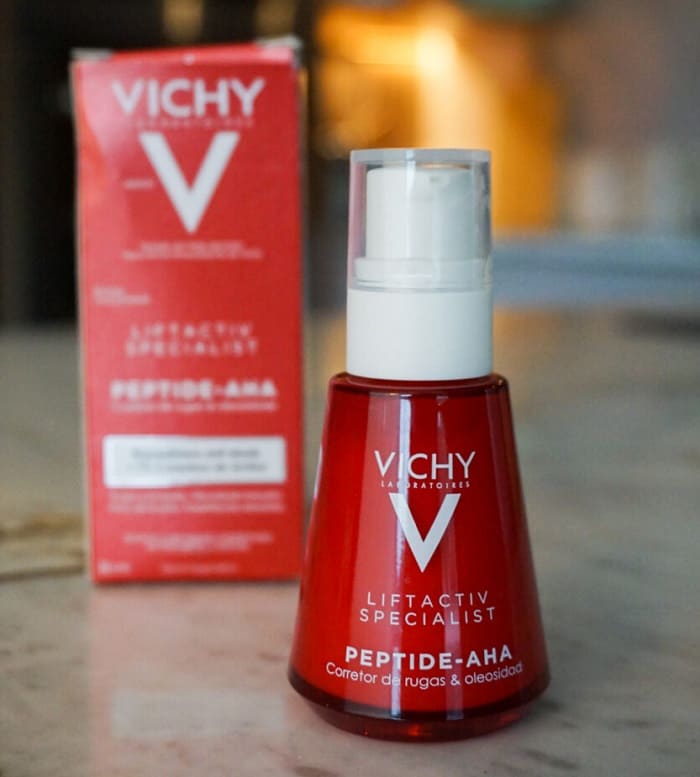Mixing peptides and AHAs (alpha-hydroxy acids) may not be recommended because AHAs are exfoliants that work by removing dead skin cells and can potentially break down the peptides, rendering them ineffective. Additionally, AHAs can cause skin irritation or sensitivity, which can further compromise the effectiveness of peptides.
It’s generally recommended to use AHAs and peptides at different times of the day or in separate steps of your skincare routine. For example, you could use AHAs in your evening routine and peptides in your morning routine, or use an AHA product one day and a peptide product the next day.
If you do choose to use both peptides and AHAs in your skincare routine, it’s best to consult with a dermatologist or skincare professional for personalized advice on how to use them effectively and safely.
What can you not mix with peptide?
Peptides, specifically copper peptides, have gained popularity in the skincare industry for their ability to enhance skin renewal. However, it is essential to understand the potential risks associated with combining certain skincare products. In particular, it is important to note that copper peptides should not be mixed with vitamin C.
Although vitamin C is known for its antioxidant properties and ability to brighten the skin, it can be easily oxidized when combined with copper peptides. This oxidation process can reduce the effectiveness of vitamin C, rendering it less potent as an antioxidant. Additionally, the combination may cause skin irritation or damage.
Therefore, if you are incorporating both copper peptides and vitamin C into your skincare routine, it is recommended to use them separately. You can alternate between the two or use them in different parts of your routine, such as using copper peptides in the morning and vitamin C at night. By doing so, you can reap the benefits of both ingredients without risking adverse effects on your skin.
What should you not mix with AHA?
Don’t Mix: AHA/BHA acids with retinol. “I strongly caution those also using retinoids for acne or anti-aging as the combination with various acids may cause excessive skin sensitivity, irritation, and redness. In fact, AHA and BHA should not typically be used together with retinoids on the same day.
What can I combine AHA with?
“AHA, BHA, retinol, and benzoyl peroxide can be mixed with moisturizing ingredients like hyaluronic acid, ceramides, and rosehip oil to get effective results — just ensure you are not using retinol as well as AHA or BHA’s during the day,” says Graf.

Can I mix peptide with niacinamide?
“Niacinamide and peptides are completely safe to use together, and both are great options for all skin types,” says New York City board-certified dermatologist Dr. Marisa Garshick.
Can you mix peptide with vitamin C?
So, how about using peptides and Vitamin C together? The short answer is that yes, you can use these two together as these ingredients complement each other. They both benefit the skin and keep the skin barrier strong and healthy.
Can you mix peptide and retinol?
This is largely due to the fact that both ingredients are so powerful but we have great news: the short answer to this question is yes, you can use retinol and peptides together! In fact, they compliment each other very well!
Can peptides and retinol be used together?
In fact, they compliment each other very well! Because retinol can cause irritation and dryness in the skin, peptide comes along and helps reduce that irritation and strengthens the skin. They both also have great anti-aging properties, so you would do well by including both in your skincare routine.
What can you not mix peptides with?
Peptides are usually not mixed with AHA (Alpha Hydroxy Acids) because acidic pH is undesirable for peptides. AHA is a group of natural acids found in foods. Example- citric acid (found in citrus fruits), tartaric acid (found in grapes), lactic acid (found in sour milk and tomato juice), etc.
Can I use peptides after AHA peel?
Also avoid combining the peel with pure or ethylated Vitamin C, retinoids including retinol, copper peptides, The Ordinary EUK134 0.1%, peptides, The Ordinary 100% Niacinamide Powder and benzoyl peroxide.
Is AHA and peptide the same?
Peptides and AHA’s are often mistaken for having the same effect on the skin but they are very, very different.
When should I start using peptides?
I recommend adding a peptide to your skincare routine sometime during your mid 20’s to early 30’s as this is when collagen production naturally slows down. However, adding a peptide to your skincare routine will help your skin appear more youthful no matter where you’re at.
Do peptides dry out skin?
Peptides work to rebuild and repair damaged cells and signal skin to produce collagen, slowing the aging process. This is a go-to moisturizer for a large range of women and men, including those with sensitive, dry and acne-prone skin.
What goes well with AHA?
“AHAs and BHAs can certainly be combined. For example, for oily skin, a salicylic-based cleanser can be used followed by a glycolic acid toner. Generally, a glycolic acid is great for dry, dehydrated or combination skin, whereas salicylic acid would be perfect for oily/spot-prone/acne skin.
What works best with AHA?
Cheung recommends you layer AHAs with Vitamin C because they both work around a similar PH level. She suggests that you avoid combining AHAs and retinol because they are both exfoliants that can irritate your skin.
What should you not layer with AHA BHA?
AHAs and BHAs, such as glycolic, salicylic, and lactic acids should never be used with Vitamin C. Vitamin C is an acid, too, and is unstable, so the pH balance will be thrown off by layering these ingredients together and might as well be useless.